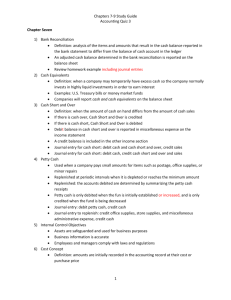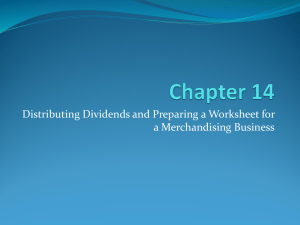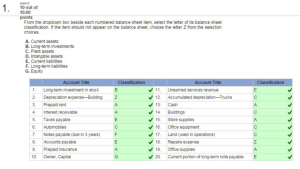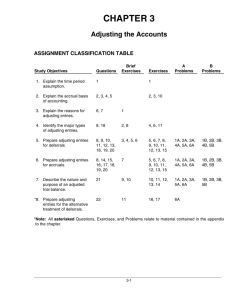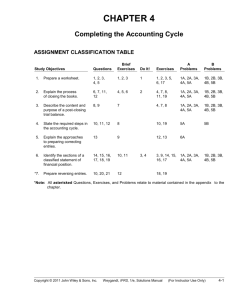Adjusting Entries Examples
advertisement
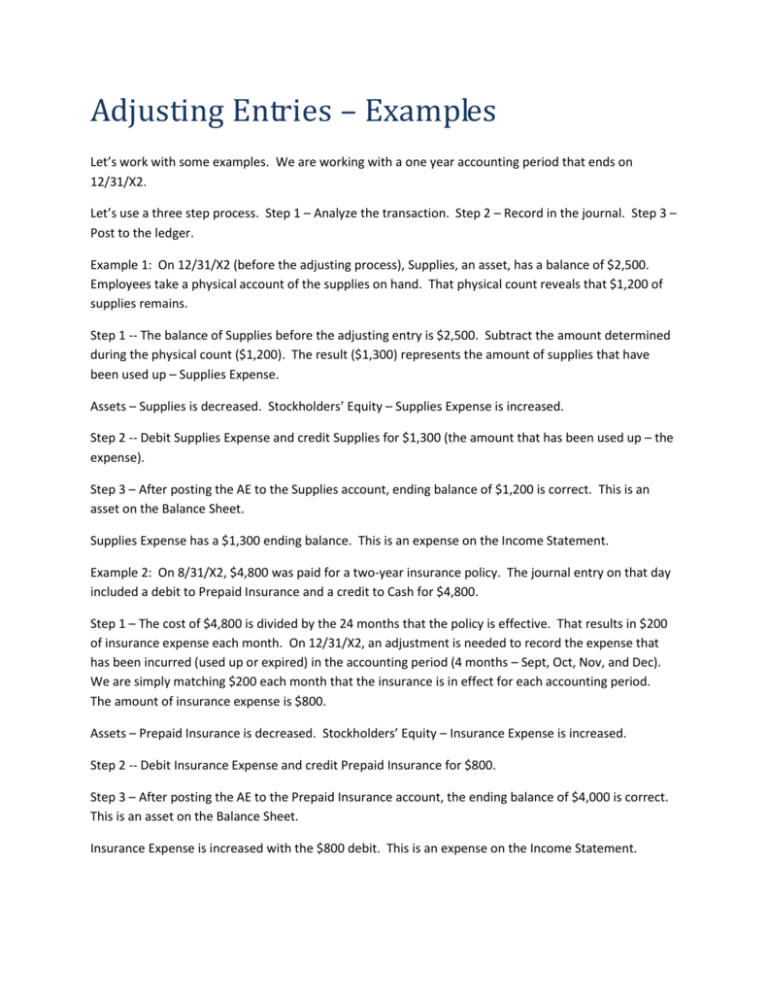
Adjusting Entries – Examples Let’s work with some examples. We are working with a one year accounting period that ends on 12/31/X2. Let’s use a three step process. Step 1 – Analyze the transaction. Step 2 – Record in the journal. Step 3 – Post to the ledger. Example 1: On 12/31/X2 (before the adjusting process), Supplies, an asset, has a balance of $2,500. Employees take a physical account of the supplies on hand. That physical count reveals that $1,200 of supplies remains. Step 1 -- The balance of Supplies before the adjusting entry is $2,500. Subtract the amount determined during the physical count ($1,200). The result ($1,300) represents the amount of supplies that have been used up – Supplies Expense. Assets – Supplies is decreased. Stockholders’ Equity – Supplies Expense is increased. Step 2 -- Debit Supplies Expense and credit Supplies for $1,300 (the amount that has been used up – the expense). Step 3 – After posting the AE to the Supplies account, ending balance of $1,200 is correct. This is an asset on the Balance Sheet. Supplies Expense has a $1,300 ending balance. This is an expense on the Income Statement. Example 2: On 8/31/X2, $4,800 was paid for a two-year insurance policy. The journal entry on that day included a debit to Prepaid Insurance and a credit to Cash for $4,800. Step 1 – The cost of $4,800 is divided by the 24 months that the policy is effective. That results in $200 of insurance expense each month. On 12/31/X2, an adjustment is needed to record the expense that has been incurred (used up or expired) in the accounting period (4 months – Sept, Oct, Nov, and Dec). We are simply matching $200 each month that the insurance is in effect for each accounting period. The amount of insurance expense is $800. Assets – Prepaid Insurance is decreased. Stockholders’ Equity – Insurance Expense is increased. Step 2 -- Debit Insurance Expense and credit Prepaid Insurance for $800. Step 3 – After posting the AE to the Prepaid Insurance account, the ending balance of $4,000 is correct. This is an asset on the Balance Sheet. Insurance Expense is increased with the $800 debit. This is an expense on the Income Statement. Example 3: On 4/1/X2, the company acquired $240,000 of equipment for cash. The entry on that date is a debit to Equipment and a credit to Cash for $240,000. Management expects to use the equipment for 8 years, thus the estimated useful life is 8 year. At the end of 8 years, the equipment will have no salvage value. Straight line depreciation is used. Depreciable cost (cost less salvage value) is divided by the estimated useful life. Remember that depreciation is the allocation of the cost of the asset over its estimated useful life. The computation of depreciation is: Cost $240,000 divided by estimated useful life of 8 years equals $30,000 depreciation expense each year. The adjustment for 12/31/X2 requires the $30,000 annual depreciation expense to be prorated based on the months of actual use. The equipment was used for 9 months (April through December). Thus $30,000 times 9/12 equals $22,500. Now that we know the amount of deprecation expense for the year, we have to determine which accounts to use. The contra asset- Accumulated Depreciation – Equipment is increased and the Stockholders’ Equity account – Depreciation Expense is increased. $22,500 is debited to Depreciation Expense. The credit, however, does not go directly to the asset account (Equipment). A contra asset, Accumulated Depreciation, is used. This allows the asset to reflect the purchase price. Accumulated Depreciation reflects the total of all deprecation that has been recorded for the asset. The AE – Debit Depreciation Expense and Credit Accumulated Depreciation for $22,500. On the Balance Sheet, the balance of Accumulated Depreciation is subtracted from the Equipment account. The balance represents the book value (also referred to as the carrying value) of the asset.The 12/31/X2 Balance Sheet reflects: Assets Property, Plant and Equipment Equipment Less Accumulated Depreciation Book Value $240,000 22,500 $217,500 Depreciation expense goes on the Income Statement. Example 4: On 7/25/X2, a law firm and its client sign a contract and the client pays $8,400 cash. The contract states the law firm will provide monthly legal services for 12 months, beginning on 8/1/X2. A regular journal entry is needed on 7/25/X2 – debit Cash and credit Unearned Revenue for $8,400. On 12/31/X2, an adjusting journal entry is needed to record the amount of revenue that has been earned. The entry also results in the correct balance of the liability account as of 12/31/X2. Computation: $8,400 divided by 12 months equals $700 per month. $700 times 5 months (Aug – Dec) equals $3,500. $3,500 has now been earned. This complies with the revenue recognition principle – record revenue when it is earned. The liability is reduced because the services have been provided for 5 months. Liabilities – Unearned Revenue is decreased. Stockholders’ Equity – Legal Fees Earned is increased. The journal entry includes a debit to Unearned Revenue and a credit to Legal Fees Earned for $3,500 When the debit of $3,500 is posted to Unearned Revenue, the ending balance will be correct ($8,400 less $3,500). Legal Fees Earned goes to the Income Statement. Example 5: On 12/31/X2, the accountant questions the managers and discovers that revenue of $12,500 has been earned (the services have been provided) but the clients have not yet been billed. This is an accrual of revenue. Revenue has been earned and must be recorded to comply with the revenue recognition principle. The client billings will occur later. Accounts affected – Assets – Fees Receivable is increased and Stockholders’ Equity – Service Revenue is increased. The AE – Debit Fees Receivable and credit Service Revenue for $12,500. Step 3 – After posting the debit to Fees Receivable, the account has the correct ending balance of $12,500. This is an asset on the Balance Sheet. Service Revenue goes to the Income Statement. Example 6: On 10/1/X2, the company provides services of $15,000 to a client. The client will not be able to pay for the services until 4/1/X3. Thus, the client signs a promissory note for 6 months. The note bears 6% annual interest. The regular entry on 10/1/X2 is a debit to Notes Receivable and a credit to Service Revenue. Interest is not recorded until time has passed – interest has been earned. On 12/31/X2, the client now owes interest, but cash is not due until maturity date. The company has earned interest for 3 months (Oct, Nov, and Dec). The computation is Principal times Rate times Time -$15,000 times 6% (or .06) equals $900 times 3/12 equals $225. Assets – Interest Receivable is decreased. Stockholders’ Equity – Interest Revenue is increased. Step 2 -- Debit Interest Receivable and credit Interest Revenue for $225. Step 3 – After posting the AE to Interest Receivable, the ending balance of $225 is correct. This is an asset on the Balance Sheet. Interest Revenue goes to the Income Statement. Example 7: 12/31/X2 is on Tuesday. There are 3 employees who are each paid $120 per day (disregard employment taxes – these will be covered later). The work week is Monday through Friday and payday is every Friday. The next payday is 1/3/X3. On 12/31/X2, the employees have worked two days (Monday and Tuesday). The accounting period has ended but payday is on Friday (1/3/X3). An adjusting entry is needed to record the salaries expense for 12/30 and 12/31. This matches the expense to the proper accounting period. It also recognizes the liability on 12/31 (two days of salaries that will be paid on 1/3/X3). Computation -- $120 per day times 3 employees times 2 days equals $720. Accounts Affected: Liabilities – Salaries Payable is increased. Stockholders’ Equity – Salaries Expense is increased. The 12/31/X2 adjusting entry is a debit to Salaries Expense and a credit to Salaries Payable for $720 Step 3 – After posting the credit, Salaries Payable has the correct ending balance. This will appear as a liability on the Balance Sheet. Salaries Expense goes to the Income Statement. The regular entry on payday – 1/3/X3 is: Salaries Expense ($120 per day times 3 employees times 3 days) $1,080 Salaries Payable 720 Cash ($120 per day times 3 employees times 5 days) 1,800 This regular entry decreases the liability that was created on 12/31/X2. It records the salaries expense for the three days in the new accounting period (Wed, Thurs, and Fri). It also records the cash that is paid to the employees for 5 days (Mon - Fri. We have had an opportunity to work with adjusting entries – Practice. We have worked with the three step process for adjustment – analyzing, recording, and posting – Confidence Builder Accountants must analyze account balances and events to determine which adjustments are needed. This results in a compliance with both the matching and revenue recognition principles. After the adjusting entries have been posted to the ledger accounts, correct financial statements can be prepared.




